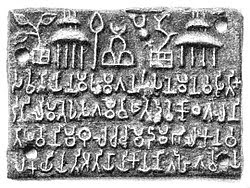Sohgaura copper plate inscription
| Sohgaura copper plate inscription | |
|---|---|
 The Sohgaura copper plate. | |
| Material | Copper plate |
| Writing | Brahmi script |
| Created | 3rd century BCE |
| Period/culture | 3rd Century BCE |
| Discovered | 26.57°N 83.48°ECoordinates: 26.57°N 83.48°E |
| Place | India |
| Present location | Sohgaura |
The Sohgaura copper plate inscription is an Indian copper plate inscription written in Prakrit in the Brahmi script. It was discovered in Sohgaura, a village on the banks of the Rapti River, about 20 km south-east of Gorakhpur, in the Gorakhpur District, Uttar Pradesh, India.[1]
The plate, consisting of a line of symbolic drawings and four lines of text, is the result of a molding.[2] The inscription is sometimes presented as pre-Ashokan, even pre-Mauryan, but the writing of the plate, especially the configuration of akshara would rather suggest a date after Ashoka.[2] Nowadays, this plate is generally considered to be from the Maurya period, and seems to be part of the larger set of inscriptions (the Edicts of Ashoka), written by Ashoka through India.[3]
The text of the plate has been translated as follows. Its mentions the establishment of two grain depots (Kosthagara) to fight against famine.[4]
Sāvatiyānam Mahāma(ttā)nam sāsane Mānavāsītika-
ḍasilimate Ussagāme va ete duve koṭṭhāgālāni
tina-yavāni maṃthulloca-chammā-dāma-bhālakān(i)va
laṃ kayiyati atiyāyikāya no gahi(ta)vvāya[5]At the junction called Manawasi,
these two storehouses are prepared,
for the sheltering of loads of commodities,
of Tiyavani, Mathura and Chanchu.— Translated by Fleet[2]
This is the oldest Indian copper plate inscriptions known.[3][4]
See also[edit]
References[edit]
- ^ THE SOHGAURA COPPER-PLATE REGISTRATION BM Barua Annals of the Bhandarkar Oriental Research Institute Vol. 11, No. 1 (1930), pp. 32-48 [1]
- ^ Jump up to:a b c Sircar 1942 Select Inscriptions Vol 1 OCR p.85
- ^ Jump up to:a b The Archeology of Early Historic South Asia: The Emergence of Cities and States by FR Allchin, George Erdosy p.212
- ^ Jump up to:a b 2000+ MCQs with Explanatory Notes For HISTORY by Disha Experts p.63
- ^ Barua, B. M. (1930). "THE SOHGAURA COPPER-PLATE INSCRIPTION". Annals of the Bhandarkar Oriental Research Institute. 11 (1): 48. JSTOR 41688160.
Taxila copper plate
| Taxila Copper Plate | |
|---|---|
 Taxila Copper Plate as displayed in the British Museum | |
| Material | Copper |
| Size | Height 7.5 cm |
| Created | 1st century BC - 1st century AD |
| Present location | British Museum, London |
| Registration | OA 1967.10-18.5 |
The Taxila copper-plate, also called the Moga inscription or the Patika copper-plate is a notable archaeological artifact found in the area of Taxila, Gandhara, in modern Pakistan. It is now in the collection of the British Museum.[1]
Description[edit]
The copper plate is dated to a period between the 1st century BCE and the 1st century CE. It bears an imprecise date: the 5th day of the Macedonian month of Panemos, in the year 78 of king Moga. It is thought it may be related to the establishment of a Maues era, which would give a date around 6 CE.
The copper plate is written in the Kharosthi script (a script derived from Aramaic). It relates the dedication of a relic of the Buddha Shakyamuni (Pali: śakamuni, literally "Master of the Shakas") to a Buddhist monastery by the Indo-Scythian (Pali: "śaka") ruler Patika Kusulaka, son of Liaka Kusulaka, satrap of Chukhsa, near Taxila.
The inscription is significant in that it documents the fact that Indo-Scythians practiced the Buddhist faith. It is also famous for mentioning Patika Kusulaka, who also appears as a "Great Satrap" in the Mathura lion capital inscription.




No comments:
Post a Comment